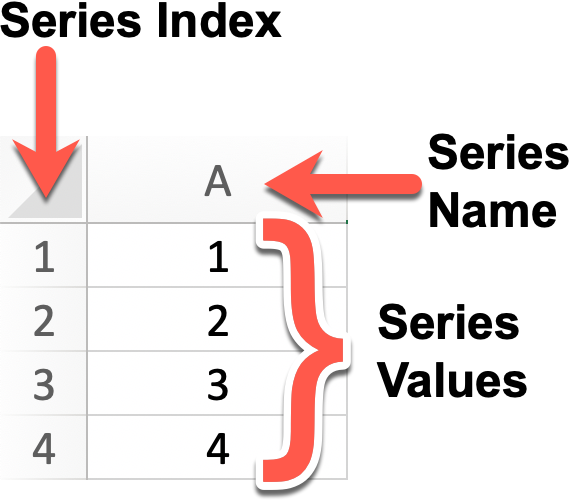Pandas 基礎まとめ
SeriesとDataFrameについて
Series
Seriesとは. 1次元の値のリスト

dict型のオブジェクトをSeriesにいれるとkeyをindexとして表現します。
data = {
"Name":"Jhon",
"Sex":"male",
"AGe":22
}
pd.Series(data)
>
Name Jhon
Sex male
AGe 22
dtype: object
Numpy arrayからSeriesを作成
array = np.array([22,31,42,23])
age_series = pd.Series(array)
age_series
arrayにindexを指定して、indexで呼び出す
array = np.array(['John','male',22])
john_series = pd.Series(array,index = ['Name','Sex','Age'])
john_seiies["Name"]
>John
john_seiries
>
Name John
Sex male
Age 22
dtype: object
元々のNumpy arrayを取ってくる
age_series.values.values
>array([22, 31, 42, 23])
DataFrame
イメージとして、行列そのものをテーブルとして扱う (行Series 列Series)を操作し組み合わせたものが、DataFrameといった感じか。
上の図では、列Seriesのみですが、
行のSeriesも扱います
Numpy array から作成
ndarray = np.arange(10).reshape(2,5)
ndarray
>
array([[0, 1, 2, 3, 4],
[5, 6, 7, 8, 9]])
pd.DataFrame(ndarray,index = ["index1",'index2'] ,columns = ['a','b','c','d','e' ])
>
| a | b | c | d | e |
| index1 | 0 | 1 | 2 | 3 | 4 |
| index2 | 5 | 6 | 7 | 8 | 9 |
基本的流れ
1 read_csvで読み込み
2 データの基礎情報を分析
df = pd.read_csv("dataset/tmdb_5000_movies.csv")
# len()でデータ数確認
len(df)
一覧を省略せず表示させたい時
# colomuの制限をなくす
pd.set_option('display.max_columns',None)
# row(1つ1つのデータ)の制限をなくす (※重たくなるので注意)
pd.set_option('display.max_rows',None)
df.describe()
type(df) #describe自体もDataFrameとして扱える
DataFrameの操作
Seriesで返ってくる
df[" カラム名 "] ○ 推奨
df.カラム名 ▲ 非推奨
DataFrameで返ってくる
df[["revenue"]]
#columを複数選択も可能
df[["revenue","original_title","budget"]]
# 特定の行のindexを指定し、取り出す
df.iloc[10:13]
# 特定の行のindexを指定し、指定したカラムを取り出す
df.iloc[10:13]["original_title"]
行・列の削除
drop() # 元のDataFrameは変更されない
inplace = True で元のDataFrameを変更する
<特定の行をまとめて削除 axis = 0 (※デフォルトで指定済)>
df.drop('id', (axis = 0) ,(inplace = True))
<指定した列を削除 axis = 1>
df.drop('id', axis = 1,(inplace = True))
df = df.drop(5) # inplaceよりメジャーな、元のデータを更新する手法! 同じ変数を使いまわしていく
dropna() 欠損値を全削除
np.isnan() nan(欠損値) があるか判定
fillna() 欠損値を埋める
>fillna(df["runtime"].mean())
Filter
フィルターのかけ方
# 例)日本の映画のみ指定したい
j_movie = df[df['original_language'] == 'ja'] #この書き方が基本よく使う
()&()や()|()で複数の条件を入れる
# 例)日本の映画で評価が8以上の作品だけ指定したい。
j_movie = df[(df['original_language'] == 'ja') & (df["vote_average"] >= 8 ) ]
df[ (df['budget'] == 0 ) | (df['revenue'] == 0 ) ]
→フィルタ :「予算もしくは売り上げが0」
df[ ~ ((df['budget'] == 0 ) | (df['revenue'] == 0 )) ]
フィルタ :「予算もしくは売り上げが0」ではない(NOT演算〜)
merge()使い方
引数howのオプション
df1 = pd.DataFrame({'key':["k0","k1","k2"],
'A':["a0","a1","a2"],
'B':["b0","b1","b2"]})
df2 = pd.DataFrame({'key':["k0","k1","k2"],
'C':["c0","c1","c2"],
'D':["d0","d1","d2"]})


